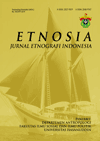Abstract
This article attempts to understand how the settlement layout of riverbank communities, with the case in the Ogan Malay community in South Sumatra province. This article is based on empirical reality in which the community tends to always live on the riverbank, especially the riverbank, with raging water. For the Ogan Malay community, the settlement is an area consisting of villages as dwellings, but also include agricultural areas (fields, fields, and gardens) and other supporting areas, as a source of life. As a riverbank community, the river has always been central in determining the layout of elements of its settlements, thus creating a unique settlement layout pattern. This article is the result of ethnographic (anthropological) research conducted by the author in April - June 2019. Data were collected through depth interviews with indigenous leaders and local communities in the location, as well as through participant observation of life activities in the research field. The results showed that living on the riverbanks is not arbitrary, but based on the community's knowledge system on the river environment itself. This knowledge creates a unique pattern of community settlement layout, where the river has always been central in the preparation of layout planning.
References
Ahimsa-Putra, H.S. (1997). “Arkeologi Permukiman. Asal Mula dan Perkembangannya” in Humaniora (5): 15-25.
Ahimsa-Putra, H.S. (1998). “Beberapa Paradigma Diakronis dalam Arkeologi Pemukiman” in Humaniora (7): 24-34.
Arifin, Z. (1998). Talang: Classification System and Pattern of Adaptation of Ogan Tribes in the Process of Forming and Structuring New Settlements. Thesis Magister Antropologi in Gadjah Mada University, Yogakarta
Arifin, Z. (2015). Kebudayaan dan Warisan Tak Benda di Provinsi Sumatera Selatan. Disampaikan dalam acara “Rapat Teknis Pelestarian Nilai Budaya dalam Rangka Penetapan Warisan Budaya Tak Benda (WBTB) Provinsi Sumatera Barat, Bengkulu dan Sumatera Selatan.” Pada tanggal 14-16 Juni 2015. Padang: Kemendikbud
Arifin, Z. (2018). Tunggu Tubang. Pattern of Power and Resource Control at Semende Community, South Sumatera. Padang: Rumah Kayu Pustaka Utama.
BPS. (2019). Kabupaten Ogan Ilir dalam Angka. Indralaya: Badan Pusat Statistik.
BPS. (2019). Kabupaten Ogan Komering Ulu dalam Angka. Baturaja: Badan Pusat Statistik.
Boster, J.S. (2012). “Cognitive Anthropology Is a Cognitive Science”, in Topics in Cognitive Science (4): 372–378.
Desfor, G., Keil, R. (2000). “Every River Tells a Story: the Don River (Toronto) and The Los Angeles River (Los Angeles) as Articulating Landscapes” in Journal of Environmental Policy & Planning 2(1): 5-23.
Guilland, D. (2006). Menyelusuri Sungai, Merunut Waktu. Penelitian Arkeologi di Sumatera Selatan. Jakarta: IRD-Enrique Indonesia.
Hanafiah, D. (1985). Melayu Jawa: Citra Budaya dan Sejarah Palembang. Jakarta: Penerbit PT. Raja Grafindo Persada.
Havrelock, R. (2007). “My Home is Over Jordan: River as Border in Israeli and Palestinian National Mythology” in National Identity 9(2): 105-126.
Intan, M.F.S. (2016). “Banyu Biru: Traces of Ancient River in Wetland”, presented at Seminar EHPA 2016, di Cirebon (25-29 October 2016).
Kasmin, Y. (2017). “Arkeologi Permukiman Situs Pongko, Kabupaten Bone, Sulawesi Selatan” in Jurnal Walennae 15(1): 43-58.
Keane, W. (2015). Why Cognitive Anthropology Needs to Understand Social Interaction and Its Mediation, in Social Anthropology 23(2):192-193.
Kumar, D. (2017). “River Ganges – Historical, Cultural and Socio-Economic Attributes” in Aquatic Ecosystem Health & Management 20(1-2): 8-20.
Langub, J., Noboru, I. (2016). Community, River and Basin: Watersheds in Northern Sarawak as a Social Linkage” in V.T. King et al. (eds.) Borneo Studies in History, Society and Culture. Singapore: Institute of Asian Studies. (pp.465-384).
Ludvik, C. (2007). Sarasvatī Riverine Goddess of Knowledge. Leiden: Koninklijke Brill NV.
Melalatoa, M.J. (2015). Ensiklopedia Suku Bangsa di Indonesia. Jakarta: Kementrian Pendidikan dan Kebudayaan.
Pahrudin. (2010). “Menyingkap Situs Koto Rayo, Pemukiman Kuno di Tepi Sungai Tabir Jambi”. Jurnal Unisia 33(73): 86-94.
Paine, L. (2018). “River Cultures in World History – Rescuing a Neglected Resource” in Fudan Journal of the Humanities and Social Sciences (online first article). (pp.1-16).
Peacock, J.L., Kirsch, A.T. (1970). The Human Directian. An Evolutionary Appraach to Social and Cultural Anthropology. New York: Appleton Century-Crofts.
Prasetyo, S.E. (2012). “Potential of Archeological Area of Flow Sungai Kikim District, Lahat District, South Sumatera” in Jurnal Papua 4(1): 51-64.
Rice, G., Urban, M.A. (2007). “Where is River City, USA? Measuring Community Attachment to the Mississippi and Missouri Rivers”. Journal of Cultural Geography 24(1): 1-35.
Ririmase, M.N.R. (2007). “Ruang Sebagai Wahana Makna. Aspek Simbolik Pola tata ruang dalam Rekayasa Pemukiman Kuno di Maluka”. Jurnal Kapala Arkeologi 3(5): 72-106.
Stahlberg, S., Svanberg, I. (2017). “When Is a Foraging Society? The Loplik in the Tarim Basin” in Victoria Reyes-García and Aili Pyhala (eds)Hunter-Gatherers in a Changing World. Switzerland: Springer International Publishing (pp.21-37)
Susanto, N.N. (2016). “Archaeological Remains and Traditions on The Barito Drainage Basin, in Barito Selatan and Barito Timur Regencies, Central Kalimantan Province”. Kindai Etam.Jurnal Penelitian Arkeologi 2(1): 51-68.
Tyler, S.A. (1969). “Introduction” in Stephen A. Tyler (eds). Cognitive Anthropology. New York: Holt, Rinehart and Winston, Inc. (pp.1-23).
Wassmann, J., Bender, A. (2015). “Cognitive Anthropology”, in James D.Wright (eds) International Encyclopedia of the Social & Behavioral Sciences (Second Edition). Orlando: University of Central Florida. (pp.16-22).





